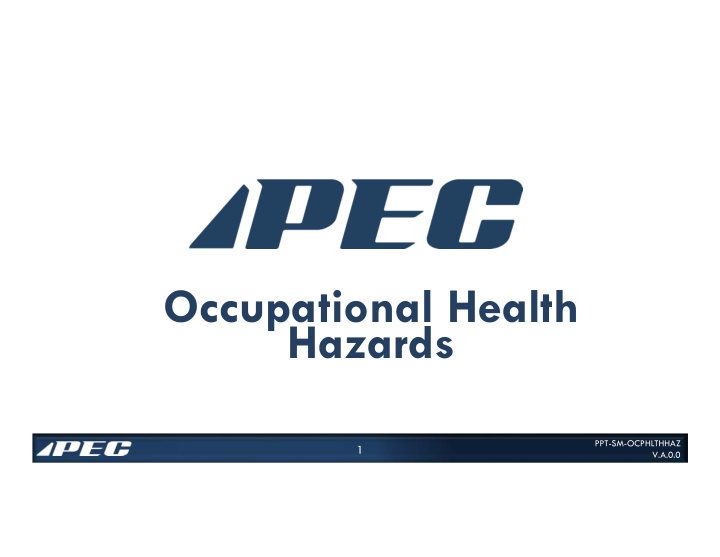



Occupational Health Hazards PPT-SM-OCPHLTHHAZ 1 V.A.0.0
Occupational Health Hazards Three classes of occupational health hazards include 1. Chemical hazards 2. Biological hazards 3. Physical hazards PPT-SM-OCPHLTHHAZ 2 V.A.0.0
Chemical Hazards • Enter body through – Inhalation – Absorption – Ingestion • Inhalation is most common route • Many chemicals cannot be detected easily by the senses • To prevent exposure – Practice proper hygiene – Wear PPE PPT-SM-OCPHLTHHAZ 3 V.A.0.0
Chemical Hazards Chemical hazards include • Sandblasting • Painting • Lead exposure • Compressed air • Benzene • Organic solvents • Carbon dioxide and nitrogen • Asbestos, fiberglass and manmade mineral fibers • Mercury • Methanol PPT-SM-OCPHLTHHAZ 4 V.A.0.0
Biological Hazards • Naturally occurring substances • Sources – Bacteria – Viruses – Fungi – Insects – Plants – Birds – Animals – Humans PPT-SM-OCPHLTHHAZ 5 V.A.0.0
Biological Hazards • Exposure through – Inhalation of dust or dander – Ingestion of contaminated food – Injected through animal bites or needle sticks • Once inside the body they can cause – Infections – Allergies – Poisoning PPT-SM-OCPHLTHHAZ 6 V.A.0.0
Biological Hazards • Be aware of site specific wildlife – Poisonous plants – Venomous snakes • Do not approach an animal • Be aware of insects that may cause anaphylactic shock – Mosquitos – Ticks – Bees PPT-SM-OCPHLTHHAZ 7 V.A.0.0
Biological Hazards Preventative measures • Properly storing food • Avoiding potentially contaminated animals • Washing hands and face • Reducing dust and aerosol levels • Proper PPE • Care when performing first aid • Avoiding contaminated items PPT-SM-OCPHLTHHAZ 8 V.A.0.0
Physical Hazards Naturally occurring radioactive material (NORM) • Found in formation material brought to surface by production of oil and gas • Levels can be dangerously high and may cause cancer • Primarily inhalation or ingestion hazard • Protection includes – Respirators and protective clothing – Site specific NORM training PPT-SM-OCPHLTHHAZ 9 V.A.0.0
Adverse Weather Conditions Lightning • Electrical discharge caused by imbalance between positive and negative charges • Can cause death • Follow company policies or local response procedures • Shelter indoors or inside a vehicle PPT-SM-OCPHLTHHAZ 10 V.A.0.0
Adverse Weather Conditions Lightning • Avoid areas that contain – Water – High elevations – Metal objects – Open spaces • Do not – Retreat under trees – Stand next to vehicles PPT-SM-OCPHLTHHAZ 11 V.A.0.0
Adverse Weather Conditions Tornadoes • Powerful events that can develop quickly with little or no warning • Tornado watch – Conditions are favorable • Tornado warning – Tornado has been seen or has formed PPT-SM-OCPHLTHHAZ 12 V.A.0.0
Adverse Weather Conditions Indoors during tornado • Go to lowest floor If there is an interior bathroom • Use the stairs in the home, it is • Stay in the center room away from a good idea to windows hide inside a • Go to a room with plenty of supports bathtub. • Crouch down • Cover head with hands PPT-SM-OCPHLTHHAZ 13 V.A.0.0
Adverse Weather Conditions Outdoors during tornado • Find a sturdy building • Stay away from trees and vehicles • Life flat and face down • Crouch down and cover head with arms PPT-SM-OCPHLTHHAZ 14 V.A.0.0
Adverse Weather Conditions In a vehicle during tornado • If the tornado is far away – Drive at right angles away from tornado • If the tornado is close – Follow outdoor procedures – Do not remain in vehicle PPT-SM-OCPHLTHHAZ 15 V.A.0.0
Adverse Weather Conditions Hurricanes • Produce strong winds and heavy rain • Hurricane season is between June 1 st – November 30 th • Companies have hurricane contingency plans PPT-SM-OCPHLTHHAZ 16 V.A.0.0
Adverse Weather Conditions Hurricanes • When a hurricane watch is issued – Begin preparations immediately • When a hurricane warning is issued – Follow the hurricane contingency plan for the facility – Follow any recommendations made by authorities – Heed all evacuation orders PPT-SM-OCPHLTHHAZ 17 V.A.0.0
Adverse Weather Conditions Tsunamis • Wreak havoc on coastal A tsunami is a series of waves. populations and landscapes Do not return to • Plan an evacuation route an affected • Know warning signs coastal area until it is safe. – Rapid rising or falling coastal waters – Rumblings of earthquake • Never stay near shore PPT-SM-OCPHLTHHAZ 18 V.A.0.0
Adverse Weather Conditions Flooding • Make sure that you have a plan • Be aware of watches and warnings • Precautions include – Preparing – Moving to higher ground – Evacuating if advised PPT-SM-OCPHLTHHAZ 19 V.A.0.0
Adverse Weather Conditions Earthquake preparation • Earthquake readiness plan • Locate a safe place in each room • Keep supplies PPT-SM-OCPHLTHHAZ 20 V.A.0.0
Adverse Weather Conditions If an earthquake occurs • Take cover under desk or table • Stay indoors until tremors stop • Stay away from furniture that can fall • Stay away from windows • Turn off your gas and water mains • If outdoors, find clear spot and drop to the ground • If in a car, stay in the car until shaking stops PPT-SM-OCPHLTHHAZ 21 V.A.0.0
PPT-SM-OCPHLTHHAZ 22 V.A.0.0
Recommend
More recommend